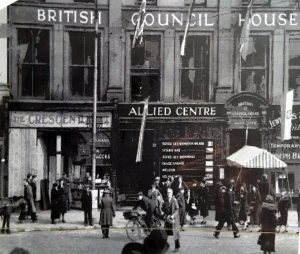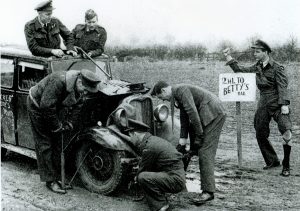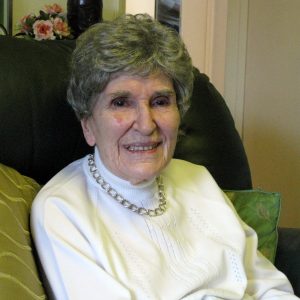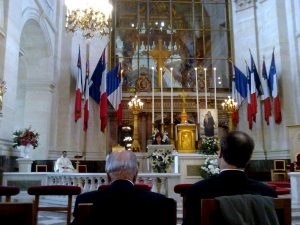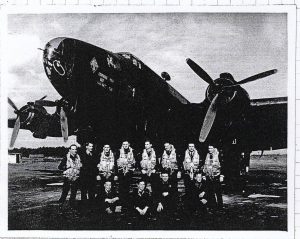Flightpaths – Henry & Pat Martin – 1943 / 1944
The compelling story of a French airman Henry Martin, who fell in love with “Pat” Pattimore, a British special agent.
The Story
Prior to the invasion of Jersey by the German Army on 1 July 1940 , Phyllis Joyce Pattimore, (aged 23) known as “Pat” to her friends, had left her family home at Grouville in the south east of the island, with her parents, and headed for England.
They moved to St Helens near Liverpool and as soon as they were established in their new home “Pat” got a job in the censorship department at the Ministry of War in Liverpool. Pat’s mother was of French decent and her daughter had grown up able to speak French fluently, and on one particular day she was approached at work by “a lady” on behalf of the government who asked, “would you like to help us”?
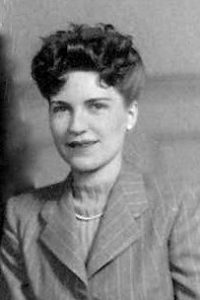
Pat Martin
Pat immediately began training in a special camp, but in her innocence she initially didn’t quite understand the consequences until she was parachuted into Normandy as a S.O.E. field agent or courier, to deliver messages to the French Resistance, using a specially made secret pouch which she carried. On her first mission her parachute became tangled in a tree and she had to wait many hours in darkness until the Resistance found her. Upon arriving at the appointed farm house, she found it had been taken over by German troops and she had to spend several weeks pretending to be a cousin visiting from Paris – even though she had never been in France on her own before. She would eventually pass on the messages and return to Britain, being picked up at sea by a British submarine.
The British Council “House” Liverpool 1943. The original had been destroyed by Luftwaffe bombers only a few months after opening in 1940.
It was later, still living in St Helens, that she joined the Association of Friends of the French Volunteers at the British Council to use her French at the special Reception Centre for French combatants arriving by ship at Liverpool Docks to join the Allies, and it was here on a fateful day in early December 1943 that she met a dashing French airman called Henry Martin.
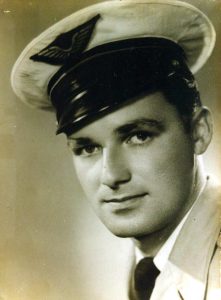
Henry Martin
Henry was 22 years old and had qualified as an air gunner on 9th June 1943, having joined the French Air Force in Algeria in 1941. He had been transferred to Britain following the Allied success over the Axis powers in North Africa. He had no idea of Pat’s “other life”.
French military personnel were joining soldiers, sailors and airmen from all over the world to continue the fight to liberate Europe. Eventually the French Air Force would create 12 aircraft squadrons including: seven fighter squadrons; two maritime squadrons; one medium bomber and two heavy bomber squadrons, all flying within the Royal Air Force.
After assimilation training into Royal Air Force protocols, operations, equipment, radio communications and aircraft types, Henry joined one of the two heavy bomber squadrons flying four-engined Halifax bombers at a Royal Air Force base near the City of York.

RAF induction training at Evanton, Scottish Highlands, February 1944. Henry is in the middle row far right.
During war, time is precious and despite being parted whilst they both undertook their various roles, Henry and Pat maintained close contact. They fell in love and Henry asked her to marry him, which they did at St Helens on 16th September 1944.
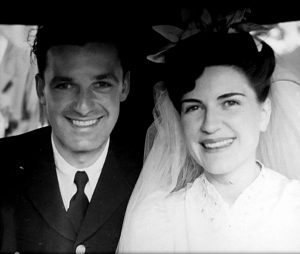
Henry and Pat Martin on their Wedding Day – 16th September 1944
After the wedding, Pat received permission to join him in York and they rented a small apartment overlooking the racecourse. From here she could sometimes see the bombers taking off from the dozens of airfields around the City and in one of these huge aircraft would be Henry.
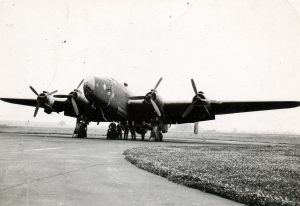
Handley Page Halifax Bomber – 346 “Tunisie” Sqdn RAF – French Air Force 1944
Following the occupation of most of Western Europe the only means of maintaining the war against Germany and her axis allies in this theatre of operations had been RAF Bomber Command, but they were paying a heavy price. The chances of survival of these young, intelligent, highly trained young men was only 50% and by the War’s end the Royal Air Force was to lose over 75,000 airmen of which 57,000 were killed in action. Following the Invasion of Normandy in June 1944 the focus of the allied bombing campaign had been the Ruhr Basin where the majority of German war manufacturing was being carried out. But it was also the most highly defended place on earth, and it was here that Henry and his squadron were facing night after night.

“Happy Valley”
The Ruhr, Germany’s industrial centre – the most heavily defended place on Earth
These young airmen lived for each day. Seeing the regular loss of their colleagues, often in terrible circumstances, they lived for the moment and Pat would often accompany Henry and his two best friends: 19 year old Jacques Leclercq (a pilot) and 22 year old Francis Usai. The “famous four” would attend the theatre, cinemas, dance halls and restaurants available in austere wartime York, a small medieval city in the rural North Riding of Yorkshire trying to adjust to bombing raids, food & clothing deprivation due to rationing and the influx of hundreds of foreign young airmen from across the world.

Jacques Leclercq, Henry & Pat Martin and Francis Usai – York, 3rd October 1944.
The French however were particularly welcomed by the local hoteliers. French airmen received a regular “ration” of French wine served at lunch and dinner on the station– a product almost unheard of in wartime Britain at that time and the prospect of serving wine to their guests was a particular bright spot, especially in the famous “Betty’s” restaurant in the centre of the City. As the “hangout” for many airmen it eventually became a shrine after a young airman “signed” his name on one of the bar’s mirrors using the diamond ring of one of the waitresses. As the war progressed many of these young signatories did not return but the mirrors can still be seen to this day reminding us a period of adrenalin fuelled hopes and fears and a passion to “live for today – while you can”.
Humorous wartime photograph of airmen “struggling to get to Betty’s” in York.
Henry and Pat lived a very short but blissful time together, and they were soon delighted to learn that Pat was now pregnant, but on the evening of 4th November 1944, just 7 weeks after the wedding, Pat was waiting by her apartment window as usual, waiting for the bombers to return from their mission and she would stay awake all night until they returned. This night’s mission was to the steel and synthetic petrol producing city of Bochum in the Ruhr. Bochum was a highly important industrial target, in fact this was the 150th mission against this city, and because of that it was also highly defended.
Henry’s Halifax bomber was one of 749 aircraft from Nos. 1; 4; 6 and 8 Groups of RAF Bomber Command, comprising 384 Halifax and 336 Lancaster heavy bombers plus 29 high speed Mosquito target location night fighters. Of these, the two French Squadrons “Guyenne” and “Tunisie” contributed 27 Halifax heavy bombers.
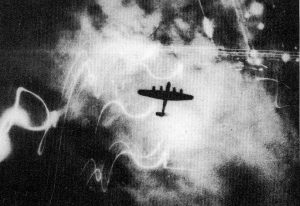
A huge array of anti aircraft weaponry and searchlights met every mission
For No. 346 “Guyenne”, the night would be a disaster. Arriving over the target in the final wave, in the evening of 4th November, their 16 Halifax bombers were the most vulnerable to attack by enemy fighters. After attacking the incoming bomber stream the German air defences were fully alert and totally familiar with the likely route taken by the Halifax crews. Consequently, “Guyenne” Squadron lost five aircraft, each with seven airmen onboard, “plus one passenger”* amounting to 36 men – all close friends. Of these, eleven were taken as Prisoners of War after baling out and parachuting to the ground. Another one successfully evaded capture but 24 lost their lives, often in catastrophic circumstances. One such aircraft was H7-G (for Georges) of Lt. Hyenne shot down by nightfighters at 8:00pm. The 7 man crew, including Henry Martin, were killed.
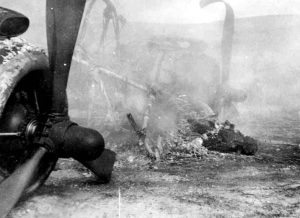
A Halifax bomber stored 2,250 gallons (10,230 litres) of ultra high octane petrol in its wings and storage tanks, plus its bomb load, making it extremely vulnerable.
It was the worst night of losses that the French were to endure during their entire service with RAF Bomber Command, although by the end of the war they had lost over 50% of their aircrews in just 8 months.
Pat was devastated and for quite a time the lack of news gave some little hope that he had survived but Pat soon learned that another crew had witnessed Henry’s plane catching fire and exploding. It was Henry’s 11th mission.
Pat Martin Woodgate, interviewed by Geneviève Monneris, September 2009, excerpt from the film “Henry & Pat, December 1943- November 1944”
Pat stayed a few months in St Helens with her parents, then in April / May 45 she went to Algiers to meet Henry’s parents, she came back at the end of May and Paul was born on 1st July 45 in London. There is some enigma about her difficulty in returning to Britain, necessitating the involvement of the security service once again and a special aeroplane journey back to the UK. Unfortunately this part of the story has never been truly explained.
«You have to live each day and not think of the next one, you do what you have to do at the time you’re able to do it. If you get through the day and you’re still alive the next day, you thank God.”
Pat Martin
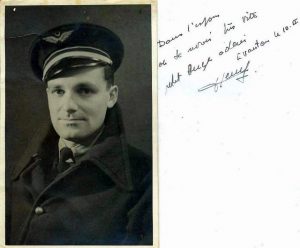
After Henry’s death she resumed work with the secret services and worked in Churchill’s famous War Rooms. She worked as an itermediary between Churchill and de Gaulle and after the War her son recalled how de Gaulle had noticed her in a crowd of observers at a ceremony in London. He had beckoned her and her little son to stand beside him for the ceremony – an acknowledgement of the acquaintence and work she had done.
Research and Film
Following the completion of her films “De Lourds Souvenirs” – IWM London Film Festival Award Winner 2012 (see “L for Love”), and “À part ça tout va bien”, Geneviève Monneris was looking to explore the wartime prspectives of women on the other side of these famous stories, and in May 2009 at the annual commemoration for the two French heavy bomber squadrons in Normandy, she met the son of Henry & Pat Martin. Paul de Seja Martin told her the fascinating tale of his parents and their unusual but tragic wartime story, and a few months later Geneviève and Ian Reed were on their way by train to Charmouth in Dorset to interview and film Paul’s 92 year old mother Pat Martin.
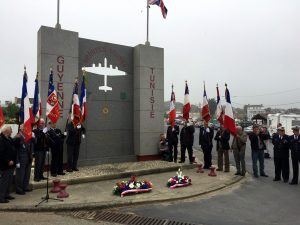
Groupes Lourds – Guyenne & Tunisie Memorial, Grandcamp Maisy, Normandy.
Pat’s had kept her wartime story secret because of the Official Secrets Act and although more than 60 years had passed, she still contacted the security services in London before Geneviève’s visit to ensure all was approved.
The documentary film “Henry & Pat” (Flightpaths) was created but the research led directly to the discovery of the photograph of the “Famous 4” and the “Francis Usai Letters” – the largest collection of wartime letters in France – a major historic discovery, but that’s another story (see La Photo).
Pat Martin Woodgate (aged 92) at her home in Charmouth, Devon in 2009
Sadly, Henry and Pat’s son Paul, died in 2011 followed soon after by Pat herself, but her words had been recorded and whilst their whole family line was now to disappeared completely, we now have the story for posterity.
Addendum:
On 6th August 2013 the Mayor and people of the seaside town of Cancale, Henry’s family home on the coast of Brittany, erected a permanent monument to his memory in a special ceremony attended by Geneviève Monneris, Ian Reed & Dr J-P Churet of Les Amicale des Groupes Lourds .

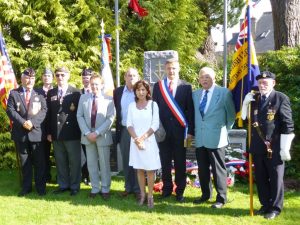
Memorial to Henry Martin – Cancale, Brittany – 6th August 2013.
The Bochum Raid
The loss of the five French bombers on the Bochum Raid, including that of Henry Martin and his crew, is still remembered. Until 2020 every year on the 4th November veterans, families and friends of the two French heavy bomber squadrons within the Groupes Lourds Association, plus British and French air force representatives, remembered that fateful night in November 1944 at a special ceremony at the Cathedral of St Louis, beside the tomb of Napoleon within Les Invalides in central Paris.
Association des Anciens et Amis des Groupes Lourds, Annual Commemoration – 4th November 2014 – Cathedral of St Louis, Les Invalides, Paris.
On that single night of the 4th November 1944 the Royal Air Force lost 40 heavy bombers (Lancasters and Halifax’s) on various missions over enemy territory – 136 airmen were killed, the rest were injured or taken prisoner. The five French aircraft of 346 “Guyenne” Squadron which were shot down were as follows:

Lieutenant Auguste Hyenne, navigator & captain (KIA) ; Sergent Guy Roca, pilot (KIA) ; Adj-chef Jean Chabroud, bomb-aimer (KIA); Sergent-chef Louis Maxerat, radio operator (KIA); Sergent-chef Jean Laherrere, flight-engineer (KIA); Sergent Henry Martin, mid-upper-gunner (KIA); Sergent Jean Reynal, rear gunner (KIA).

Halifax NR181 H7-J
Capitaine Robert Baron, pilot (KIA); Lt. Armand Truche. navigator (Evader); Adj. Guy Vigneron bomb-aimer (KIA); Adj. Rene Mignot, radio operator (PoW); Sgt./C Charles Cormier, flight engineer (KIA); Sgt./C Roger Petitjean, rear gunner (PoW); Sgt. Louis Bourelly, mid upper gunner (KIA).
* Lt. Col. N. Dagan (not in picture) of the Free French HQ in London was a passenger assessing a typical mission (KIA). This was Robert Baron’s 26th and last scheduled operation.
Halifax NA 121 H7- D. Lt. Maurice Dabadie, capitaine, navigator (KIA); Adjutant. R. Guise, pilot (KIA); Sous Lt. Alfred Pothuau, bomb-aimer (KIA); Sgt. A. Alavoine, radio operator (PoW); Sgt. Henri Lelong, flight engineer (KIA); Sgt. Jacques Vautard, mid upper gunner (PoW); Sgt. Marcel Vega, rear gunner (KIA)

Halifax NA549 H7-M and crew (L-R in flying suits): Capt. Alphonse Beraud, pilot (KIA); Lt. Pierre Vallette, navigator (PoW); Lt. Pierre Raffin, bomb-aimer (KIA); Adjutant Jean Cloarec, radio operator (PoW); Sgt. P. Imart, flight engineer (PoW); Sgt/C J Bellon, mid upper gunner (PoW) Adj. Jacques Manfroy, rear gunner (PoW). Picture includes the aircraft’s ground crew.

(no Photograph of the aircrew currently available)
Halifax NA558 H7-N Lt J Vles, capitaine, navigator (KIA); Adj R Hannedouche, pilot (PoW), S.Lt J Lambert, bomb-aimer (KIA); Sgt R Vlaminck, radio operator (PoW), Sgt Q.M. Olive, rear gunner (evader KIA); Sgt R Limacher, mid upper gunner (KIA), Sgt N Beauvoit, flight engineer (KIA).
KIA – Killed in Action; PoW – Prisoner of War; Evader – Escaped
Note: in French aircraft the pilot is not necessarily the captain.
Produced for AFHG/GPFA by Geneviève Monneris & Ian Reed ©AFHG2017

